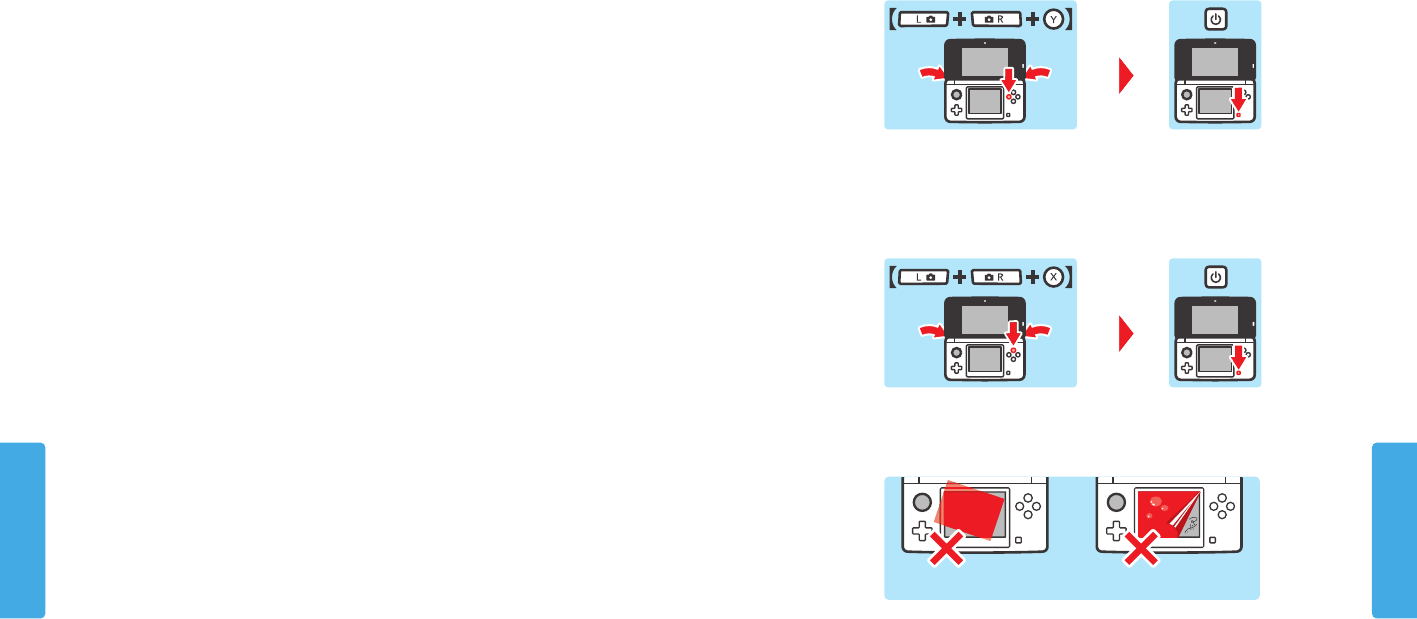
Consumer Information
Consumer Information
6564
Troubleshooting
Troubleshooting
The Game Card’s software icon does not appear on the HOME Menu, or the message
“There is nothing inserted into Game Card slot” is displayed on the HOME Menu, even
though a Game Card is inserted in the Game Card slot.
• Make sure the Game Card is completely inserted into the Game Card slot until it clicks into place.
• Check the Game Card connectors and Game Card slot for dirt, dust, or other foreign material.
• Make sure the Game Card is for your region (see the Game Card package for this information).
An error message appeared when playing Nintendo DS or Nintendo DSi software:
“An error has occurred. Press and hold the POWER Button to turn the system o. Please refer to the
Operations Manual for details”
• Turn o your system, then on again. Try repeating the same action that caused the error message to occur. If the same error
occurs again, please visit support.nintendo.com for assistance and additional troubleshooting and repair options, or call
1-800-255-3700.
I can’t see the 3D eect in images taken with the outer cameras.
• Make sure the image was taken with the outer cameras, not the inner camera.
• Make sure the lenses for the outer cameras are clean and free of dirt or dust. Clean with a soft, dry cloth if necessary.
• Make sure there isn’t a strong light such as direct sunlight shining on the camera lenses.
IMPORTANT: If your Nintendo 3DS system has been subjected to a physical shock or high temperatures, this could change the
alignment of the outer cameras and aect the 3D image quality. If you think your system may be aected by this, see page 54 for
more information on realigning the cameras.
When I take pictures with the Nintendo 3DS, the colors don’t seem correct.
• Check the camera mode settings for the cameras (see page 24).
• This may be caused by recording conditions, for example, a dark environment with subject matter of mostly one color that takes
up most of the view. Try adjusting the settings for the cameras, and taking additional photos to see if the problem is corrected.
The screen brightness or image colors change, or bright colors appear pale.
• If power-saving mode is on, these may be adjusted automatically to save battery power. For normal appearance, turn the power-
saving mode o (see page 26).
Some pixels on either the upper or lower screen are always dark or lit.
• Due to the characteristics of liquid crystal displays, a small number of pixels may not illuminate, or may always stay lit. This is
normal and not considered a defect unless the number of pixels that don’t function normally increase over time.
The brightness or color between the upper and lower screens seems dierent.
• The specications of the upper and lower screens are dierent so the appearance of images may be dierent. This is normal and
is not considered a defect.
The system registers control input when you aren’t operating the controls, or the controls
don’t seem to operate correctly.
• If you use excessive force to operate the Circle Pad, or you use the Circle Pad continuously for a long period of time, in very rare
cases the Circle Pad may start registering incorrect input and need to be calibrated. Use the calibration procedure in System
Settings to recalibrate the Circle Pad (see page 54).
NOTE: You can also go directly to the Circle Pad calibration procedure by following this procedure. First turn the power o. Then
hold down the L Button, R Button, and Y Button and turn the system on as shown below.
The Touch Screen doesn’t seem to operate or respond correctly to stylus input.
• The Touch Screen may need to be recalibrated. Use the calibration procedure in System Settings to recalibrate the Touch Screen
(see page 54).
NOTE: You can also go directly to the Touch Screen calibration procedure by following this procedure. First turn the power
o. Then hold down the L Button, R Button, and X Button and turn the system on as shown below.
• If you have attached a screen protector (sold separately) incorrectly to the Touch Screen, try removing it and using the Touch
Screen again. If it operates correctly, either try reattaching the screen protector, carefully following the instructions included with
it, or avoid using one. (Please use screen protectors ocially licensed by Nintendo.)
While holding,
press
Not aligned correctly Dirt or air bubbles present
While holding,
press
